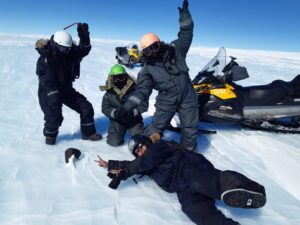
As glaciers around the world transform into rivers and ultimately dry ravines, entire ecosystems will be changed forever. While we often talk about the problems that will be faced by polar bears and benguins, we must also consider the less fluffy endangered creatures, such as the rare planetary science graduate student. This starved-for-data subgroup of humans, along with the more common geology graduate student, is known to migrate by the dozen to glaciers every summer as they search out one of their favorite research foods: meteorites.
Working side-by-side with members of their subgroup who have somehow survived to become senior scientists and faculty, these early-career researchers learn to forage along the melting ends of glaciers and their surfaces for meteorites that have landed on the glacier at some point in history and have now been revealed by the glaciers’ melting.
It is estimated that 300,000 meteorites are at the surface of the Antarctic ice sheet. During their summer meteorite hunt, eager researchers can gather up to 1,000 meteorites that can feed them for months or even years. Without climate change, these rare scientists could go centuries without needing to find a new hunting site.
Unfortunately, because of climate change, things are going to get much harder for these young researchers. With every 1/10 degree of warning, it’s estimated that 5,100 to 12,200 meteorites will be lost from the ice sheet. By 2050, it’s estimated that a quarter of these precious space rocks could be lost forever. These lost space rocks could contain the samples needed for these students to get PhDs… or maybe even discover life from other worlds.

It is up to all of us to protect all the rare and endangered flora, fauna, and researchers in this world. In the words of Harry Zekollari, “To secure this invaluable extraterrestrial material, we need to intensify and coordinate the recovery of Antarctic meteorites before we lose them to climate change. In similar efforts as collecting ice cores from vanishing glaciers or sampling coral reefs before they bleach, our study identifies the loss of meteorites as an unexpected impact of climate change upon which we need to act”.
If you want to help protect these students, please consider donating to your local geology and planetary science programs, getting involved in efforts to restrict greenhouse emissions, and spreading the word that space rocks and the grad students who research them may just be the next victim of climate change.
